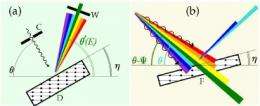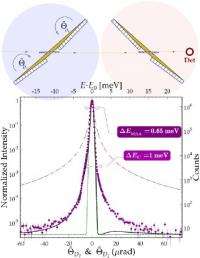The road to ultrahigh-resolution X-ray spectrometers

Two recent developments at the Advanced Photon Source explore paths to routine use of sub-meV x-rays to probe low-energy excitations in matter. The first is a remarkable experimental demonstration of an x-ray optical scheme that produces x-ray beams with sub-meV linewidths (FWHM) and elimination of the normal Lorentzian tails. The second is a proposal for an alternate optical scheme that may achieve comparable x-ray bandwidths with less demanding optics. These two developments are described below.
Angular dispersion and anomalous transmission cast ultra-monochromatic x-rays
Despite many recent advances in inelastic x-ray scattering (IXS) and inelastic neutron scattering, critical voids exist in current experimental capabilities for investigation of atomic dynamics in biomaterials (e.g., DNA, lipid bilayers, proteins), in many intriguing classes of oxide materials (high-temperature superconductors, colossal magnetoresistance manganites, multiferroics), and many other materials with diverse properties of fundamental and practical interest. These voids call for new hard x-ray spectrometers capable of not only achieving small spectral bandwidths ΔE in the 0.1-1 meV range (ΔE/E ≈ 10-7 − 10-8), but even more importantly, the ability to detect faint spectral objects, which require small bandwidth at the 10−3- to 10−4-level fraction of the spectral resolution function maximum, i.e., steep tails and large spectral contrast.
Long Lorentzian tails of the spectral functions are a major bottleneck in the development of state-of-the-art IXS spectrometers, and as an intrinsic property of Bragg reflection profiles, were deemed to be unavoidable.
Researchers from Argonne National Laboratory have introduced a solution for this problem and have experimentally demonstrated its feasibility with high-brightness x-rays at the U.S. Department of Energy Office of Science’s Advanced Photon Source at Argonne, utilizing the X-ray Science Division 30-ID beamline, which is dedicated to IXS.
As reported by these researchers in Physical Review A, spectral distributions of x-rays can be shaped to profiles with Gaussian-like tails and extra-small bandwidths by using a combined effect of angular dispersion and anomalous transmission (AD&AT) of x-rays in Bragg reflection from asymmetrically cut crystals. The basic phenomena underlying the AD&AT x-ray optics are illustrated in the first figure.

The AD&AT-type of x-ray optics was implemented as a five-reflection, three-crystal arrangement, termed CDFDW monochromators or CDFDW analyzers. The abbreviation reflects the key functions of the five Bragg reflections involved: collimator (C), dispersing element (D), anomalous transmission filter (F), and wavelength selector (W). The optics were designed to work with medium-energy (9-keV) x-rays, where APS undulator insertion devices produce the brightest x-rays. The optics feature a combination of superlative attributes that are highly desirable for x-ray monochromators and analyzers: the exceptionally steep tail of the spectral profile (following the Gaussian dependence almost over three orders of magnitude); a narrow bandwidth of approximately 0.65 meV for a combined monochromator-analyzer spectral function; an extraordinary large angular acceptance of approximately 107 µrad; high efficiency; and in-line configuration.
Due to the sharp Gaussian tail and the 0.65-meV bandwidth, the half-width of the spectral resolution function is only 1 meV, at the level as small as 1/1000 fraction of its maximum (see the second figure). The demonstrated AD&AT optics has more than 100 times greater sensitivity to detect faint spectral objects compared to the state-of-the-art IXS spectrometers with a 1.5-meV bandwidth and Lorentzian spectral profile. For a spectrometer with a Lorentzian tail to achieve the level of sensitivity of the demonstrated AD&AT optics, its bandwidth would have to be reduced to 1/10 of the AD&AT optics bandwidth, i.e., to 0.065 meV. Such reduction, even if it were technically possible, would yield an extremely low efficiency and render data collection for IXS nearly impossible. Thus, the monochromators and analyzers based on the AD&AT principles have the great potential to become key optical components in the next-generation, ultra-high-resolution inelastic x-ray scattering spectrometers for studies of atomic dynamics, and other applications in x-ray science.
See: Yuri Shvyd’ko, Stanislav Stoupin, Deming Shu, and Ruben Khachatryan, “Using angular dispersion and anomalous transmission to shape ultramonochromatic x rays,” Phys. Rev. A 84, 053823 (2011). DOI:10.1103/PhysRevA.84.053823
The quest for modified angular dispersion schemes
Despite this successful demonstration, there is still considerable development required to turn the AD&AT optics into practical, ultrahigh-resolution IXS spectrometers. Challenges include fabrication of the meter-long dispersing crystals or the alternative “comb crystals” with stringent requirements on lattice homogeneity and surface perfection, and fabrication of collimating multilayer mirrors. Therefore, other researchers from Argonne have been working on modified schemes to mitigate these challenges. One potential alternative, recently published in the Journal of Synchrotron Radiation, is a four-bounce collimation-dispersion-dispersion-selection (4B-CDDS) analyzer, which can increase the efficiency by more than 50% by avoiding multiple-beam diffraction and Borrmann transmission-induced absorption. This scheme can achieve energy resolution from sub-meV to 20 meV with practical shorter crystals, and also has the potential to enable resonant IXS with unprecedented 10-20-meV resolution.
See: Xian-Rong Huang, “An alternative scheme of angular-dispersion analyzers for high-resolution medium-energy inelastic X-ray scattering,” J. Synchrotron Rad. 18, 899 (2011), DOI: 10.1107/S0909049511036703
Journal information: Physical Review A
Provided by Argonne National Laboratory


















